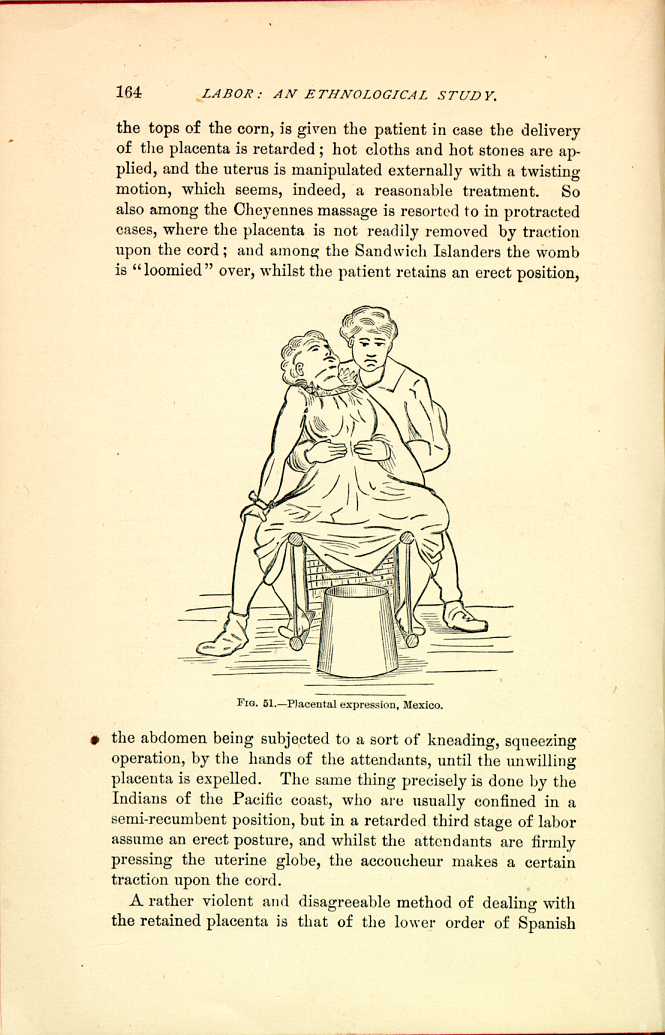| CHAPTER III. THE THIRD STAGE OF
LABOR. Labor Among Primitive Peoples | ||
MANAGEMENT OF THE PLACENTA IN CASE OF RETARDED EXPULSION.
We have already seen that, as a rule, the delivery of the placenta speedily follows the expulsion of the child, nature being merely assisted by the continuance of the external pressure, which serves to assist and facilitate the contraction of the uterine globe. If the placenta does not readily come, they are at a loss what to do, and the patient is often left to herself. Dr. C. M. Harrison writes from the Mexican frontier that the Indians, and lower order of Mexicans, seem to have no other method of extracting the placenta than by traction on the cord, and that he has seen women dead and dying merely from the want of having the placenta extracted. The Dakotas use most violent means, and if the delivery of the placenta is at all retarded, it is forcibly extracted, and often with fatal consequences. Other of the Indian tribes have more reasonable ways, and it is these which we will now consider. The description given me of the attempts at delivery of a retained placenta by a Mexican midwife, by Surgeon H. R. Tilton, U. S. Army, embodies many of the more violent methods resorted to. When called to the patient, he found that she had been given a quantity of raw beans, between a pint and a quart, as one remedy; these were probably intended to swell, and thus drive out the placenta. This failing, she had been vigorously choked, as another means of expelling the afterbirth. Finally, she was placed in the lap of her husband, in the obstetric position of that country, whilst he squeezed the abdomen powerfully with his encircling arms. This last expedient, by the way, is a favorite method among the Mexicans for facilitating labor, the contracting uterus being steadily followed down by the arms of the husband. After all these means had failed, the after-birth was readily removed by the surgeon, upon the introduction of the hand, but the recovery of the woman remained doubtful, after the violence to which she had been subjected.
In the Laguna Pueblo, a tea made of the corn blossoms, or

FIG. 51.—Placental expression, Mexico.
[Description: Woman sits on lap of a man, her legs apart over a cylindrical container. Black and white illustration.]A rather violent and disagreeable method of dealing with the retained placenta is that of the lower order of Spanish
The method of the Comanches is to grasp the womb, knead and compress it, make slight traction upon the cord, and efforts to reach the placenta with the hand, in which the patient as well as the assistant takes part. The Papagos pursue a course which is certainly peculiar to them, of producing a more steady and, perhaps, not too violent traction upon the cord, by so attaching it that the amount of force to be used is left to the judgment and the sensations of the patient; it seems as if her sense of pain were to serve as a safety valve for the amount of force to be expended, and thus the proper limit determined and dangerous consequences avoided. In the interesting description given me by Surgeon Charles Smart, U. S. Army, who was called in a case in which the placenta had been retained for three or four days, he found the attendants in great alarm for the safety of the mother. The patient lay on her side, with her knees drawn up, and every now and again, while he was learning the particulars of the case, she was directed to stretch herself out. The reason of this he found by introducing his hand for the purpose of making an examination; a buckskin thong, about the size of a whipcord, was made fast to the cut end of the funis, whilst the other extremity was discovered hitched around the great toe, and when she stretched the limb in bed traction was made
Since writing the above I learn that the Japanese, also, either carefully hold the projecting end of the cord or tie it to the patient's leg, in case the placenta should resist the simpler efforts directed toward its expulsion.
Among the Flat-heads, Pend-oreilles, and Kootewais, in case the usually speedy and natural expulsion of the placenta does not take place, the patient leaves the obstetric position, upon a low stool, and is made to stand and walk about, a proceeding which, though probably injurious to the delicate women of our civilization, is harmless and almost always successful among these Indians.
The Indians of the Misqually agency commonly use a steam bath in the very rare cases of retention. A hole is made in the ground and filled with hot rocks which are covered with leaves of the fir-tree; water is then poured upon them, and the woman made to sit over this vapor bath for a few minutes. This simple means seldom fails, and if it should, other help is called —maybe a woman, maybe a physician, if one is convenient.
| CHAPTER III. THE THIRD STAGE OF
LABOR. Labor Among Primitive Peoples | ||